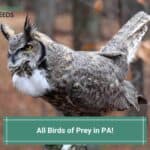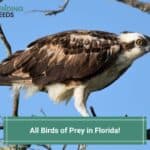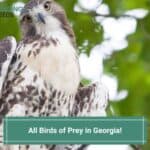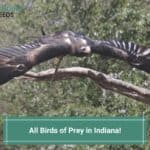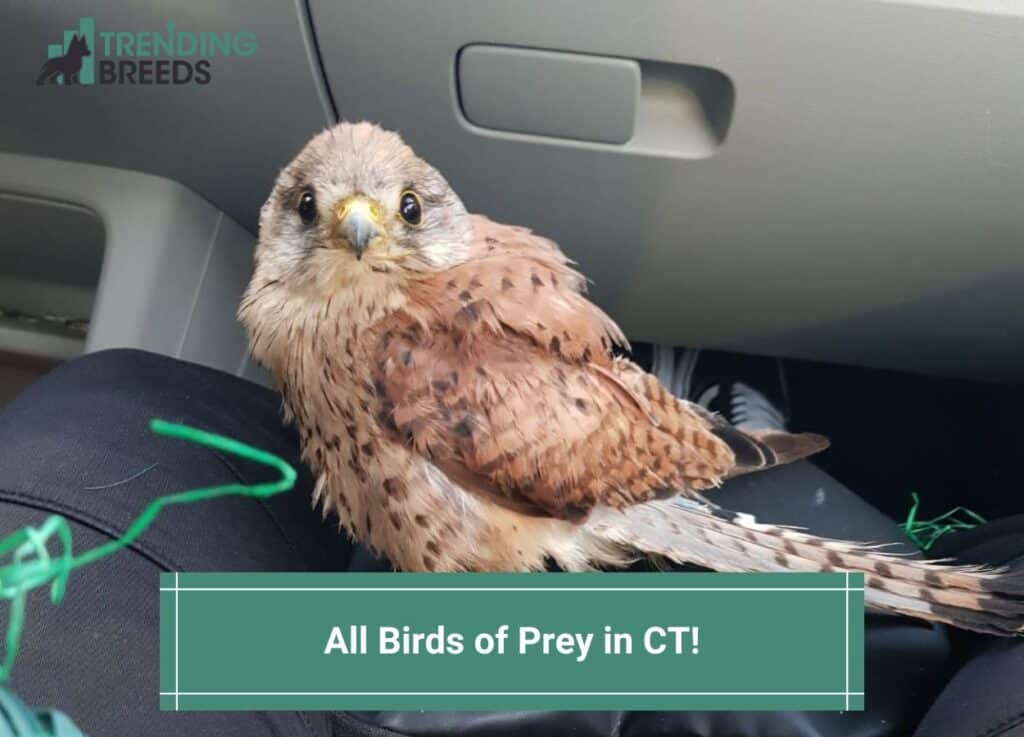
Birds of prey are majestic and fierce creatures of the skies. They have strong talons, extraordinary agility, and a keen sense of smell and sight. If you stand outside, you might catch a glimpse of some birds of prey in CT.
It’s understandable why anyone would want to get a look at these magnificent raptors in all their glory and might!
Connecticut has 32 birds of prey, including owls, hawks, vultures, eagles, falcons, osprey, and kites.
If you’re keen to spot the beautiful birds of prey in CT, this guide will help you recognize them by appearance and habitat.
Before you scroll further down this guide, check out these other animal-related articles: Best Horse Rescues in Connecticut and Best Cat Rescues in Connecticut.
Table of Contents
1. Red-Tailed Hawk
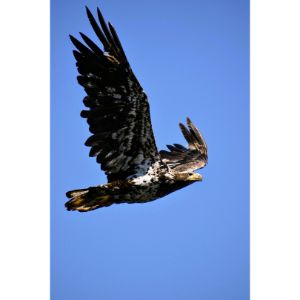
Red-Tailed Hawk Characteristics:
- Scientific Name: Buteo jamaicensis
- Size: 7-25.6 inches
- Weight: 5-3.2 lbs.
- Wingspan: 9-52.4 inches
- Life span: 20 years
- Conservation Status: Least Concern
The red-tailed hawk, nicknamed the chicken hawk, is North America’s most common hawk species.
These raptors have a characteristic wide and short red tail. They are relatively large and have broad, rounded wings.
Color is not a good indicator of the red-tailed hawk since its plumage ranges from nearly white to completely black; however, most have brown backs and a pale underbelly.
Red-tailed hawks are extremely adaptable and reside in various habitats, including parks, deserts, rainforests, woodlands, and scrublands.
Nests are found in tall trees, tall buildings, or on cliff ledges.
Although their diet consists mainly of birds, reptiles, and small mammals, especially ground squirrels, these Hawks are opportunistic generalists, meaning they’ll eat anything.
Sexually immature hawks also feed on fish, amphibians, and invertebrates.
2. Broad-Winged Hawk
Broad-Winged Hawk Characteristics:
- Scientific Name: Buteo platypterus
- Size: 5-17.5 inches
- Weight: 99 lbs
- Wingspan: 33 inches
- Life span: 12 years
- Conservation Status: Least Concern
The best time to spot the broad-winged hawk in Connecticut is during the summer since they migrate in large numbers to the southern neotropics for the winter.
These hawks are named after their distinctively broad yet fairly short wings that enable them to fly swiftly and rapidly through dense undergrowth.
They have compact, sturdy bodies, reddish-brown heads, striped breasts, and short, narrowly barred square tails.
Broad-winged hawks prefer to stay hidden in deep woods away from urban areas. They generally hunt perched on the edge of forests or near water.
Their prey consists of small mammals, snakes, frogs, and young turtles.
Although these hawks are not considered endangered, their population has significantly decreased due to forest fragmentation and deforestation.
3. Rough-Legged Hawk
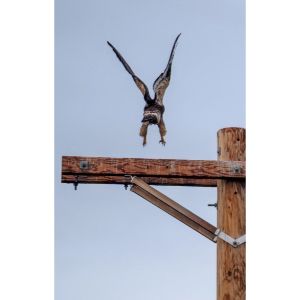
Rough-Legged Hawk Characteristics:
- Scientific Name: Buteo lagopus
- Size: 5-20.5 inches
- Weight: 58-3.09 lbs.
- Wingspan: 0-54.3 inches
- Life span: 18 years
- Conservation Status: Least Concern
Rough-legged hawks get their name from their feathered legs, which help them stay warm during the winter.
Also known as rough-legged buzzards, these large raptors exist in both light and dark morphs.
They sport dark patches on the curves of their wings, across their belly, and at the end of their tails.
Their wings are broad, narrow, and relatively long compared to other hawks.
Contrary to broad-winged hawks, rough-legged hawks are only seen in CT during the winter; they migrate to the Arctic tundra during the summer for breeding.
These birds are often seen soaring over open fields and marshes or perched on poles or fences.
Rough-legged hawks flaunt a distinctive hunting style of hovering and fronting the wind while looking for prey.
Voles and lemmings are their favorites, but they hunt ground squirrels, mice, and other small mammals.
4. Northern Goshawk
Northern Goshawk Characteristics:
- Scientific Name: Accipiter gentilis
- Size: 9-25.2 inches
- Weight: 34-3.01 lbs.
- Wingspan: 5-46.1 inches
- Life span: 11 years
- Conservation Status: Least Concern
Next on our list of birds of prey in CT is the northern Goshawk. These birds are primarily grayish-brown, with a long tail, short, broad wings, and a distinctive white stripe over their yellow eyes.
The Goshawk is found in Connecticut all year round, with the much older birds opting not to breed or migrate.
The younger hawks and juveniles opt to live further north and breed in their traditional regions in Canada.
Northern Goshawks are well-adapted to various habitats and temperatures. They can also survive in both coniferous and deciduous forests.
Since they are not strong fliers, they prefer woods with minimal undergrowth and canopy coverage to avoid getting injured or trapped.
These birds like to remain secretive and can turn aggressive if disturbed. They perch on high trees to look for prey, mainly small mammals and medium-sized birds.
5. Northern Saw-Whet Owl
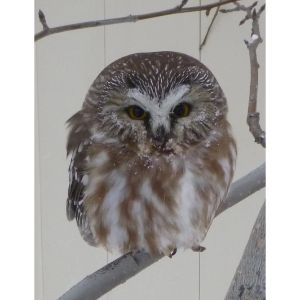
Northern Saw-Whet Owl Characteristics:
- Scientific Name: Aegolius acadicus
- Size: 1-8.3 inches
- Weight: 14-0.33 lbs.
- Wingspan: 5-18.9 inches
- Life span: 7 years
- Conservation Status: Least Concern
The northern saw-whet owl is among the smallest raptors in CT. It gets its name from the sound it produces when scared or alarmed, which mimics a saw’s ‘whetting’ (sharpening).
Adult owls have large round heads yet small bodies with white streaks on their backs and wings; thick white feathers between their bright yellow eyes form the shape of a ‘Y.’
Their bellies and chests feature white and brown streaks.
Northern saw-whet owls inhabit mixed hardwood or coniferous forests with thick branches and dense foliage.
However, they prefer to hunt near open areas and water sources.
They are good hunters and hunt voles, deer mice, shrews, squirrels, bats, and chipmunks.
Moreover, these birds of prey often complement their diet with insects, small birds, and invertebrates.
Their highly developed sense of hearing helps them hunt at night and also protects them from other predators.
6. Great Gray Owl
Great Gray Owl Characteristics:
- Scientific Name: Strix nebulosa
- Size: 0-33.1 inches
- Weight: 54-3.75 lbs
- Wingspan: 9-60.2 inches
- Life span: 15 years
- Conservation Status: Least Concern
Thanks to its large round head and facial disk, long wings, and a foot-long tail, the gray owl has earned the title of ‘Great.’
Despite having a relatively small body, its thick and fluffy feathers make it appear much bigger than it actually is.
These raptors are mostly silvery gray with pale gray, white, and brown strokes.
They have sunken yellow eyes, a curved bill with a white collar underneath. A distinct white ‘X’ appears on their faces.
Great gray owls are serious and quiet creatures that avoid people. They inhabit thick, wet, and perennial forests.
They prefer hunting in open meadows with scattered canopies, bogs, and mixed oak and pine forests.
They listen for prey silently from their perches, and once they spot it, they swoop and capture it.
Prey typically consists of small mammals such as mice, gophers, voles, lemmings, and chipmunks; however, they also hunt jays, ducks, and quail.
7. Osprey
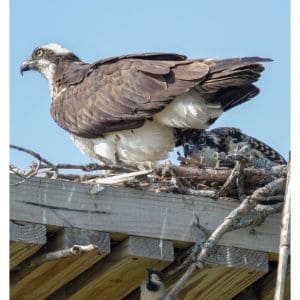
Osprey Characteristics:
- Scientific Name: Pandion haliaetus
- Size: 3-22.8 inches
- Weight: 09-4.41 lbs
- Wingspan: 1-70.9 inches
- Life span: 7-10 years
- Conservation Status: Least Concern
Ospreys are large, one-of-a-kind birds of prey, also known as sea hawks or fish hawks because they specialize in catching big, slippery fish.
The latter is aided by strong talons, spiny scales on the soles of their feet, and their outer toes curving backward.
Ospreys have yellow eyes and white heads with brown streaks on their foreheads and crowns.
A broad brown streak runs through their eyes and extends to the borders of their necks. Their breasts feature pale or dark bands, and their feet and legs are gray.
Ospreys can adapt to any habitat near water with abundant and easily accessible food. Within CT, they are mostly seen on the east and central coastline.
Since they feed mainly on fish, they hover over the water searching for it, and once spotted, they dive (talons first) to catch it.
Occasionally, or if fish is unavailable, ospreys also hunt rabbits, rodents, frogs, snakes, and birds.
8. Bald Eagle
Bald Eagle Characteristics:
- Scientific Name: Haliaeetus leucocephalus
- Size: 9-37.8 inches
- Weight: 61-13.9 lbs.
- Wingspan: 3 inches
- Life span: 20-30 years
- Conservation Status: Least Concern
The bald eagle, the national bird of the United States, gets its name from the old meaning of bald, which was ‘white-headed.’
This raptor is among the most easily recognizable birds of prey in CT and is deemed a winter visitor in the state.
It has yellow eyes and a large, curved yellow bill. It features chocolate brown plumage, yellow legs, and huge talons.
Large water bodies with a rich supply of fish are the ideal hunting ground for bald eagles.
In winter, these birds perch around unfrozen water sources looking for salmon and trout. They also sometimes feed on dead fish.
However, these raptors are opportunistic feeders, and if no water sources are available, they gather in open habitats such as prairies and meadows and hunt large birds, such as herons, ducks, owls, and geese. They also target rabbits, beavers, squirrels, raccoons, and deer fawns.
9. Golden Eagle
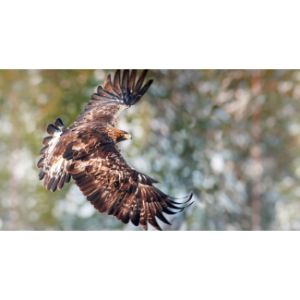
Golden Eagle Characteristics:
- Scientific Name: Aquila chrysaetos
- Size: 6-33.1 inches
- Weight: 61-13.5 lbs
- Wingspan: 8-86.6 inches
- Life span: 30 years
- Conservation Status: Least Concern
Golden eagles are the most popular birds of prey in the Northern Hemisphere and the most largely distributed eagles worldwide.
They have a golden-brown neck and crown with dark bodies and pale flight feathers.
Their eyes vary between dark brown and yellow. The skin on their beak, which attaches to their forehead, is yellow, and their bill has a dark tip.
Golden eagles are strictly territorial and avoid humans. These raptors largely inhabit mountainous areas far above tree lines, such as riverside cliffs, canyons, and bluffs.
Golden eagles are skilled hunters and use their agility, speed, and sharp talons to catch prairie dogs, rabbits, and hares.
Occasionally, they also hunt swans, cranes, and domestic livestock.
Moreover, Golden eagles generally hunt in pairs; one chases the prey and tires it out while the other dives in for the kill.
10. Peregrine Falcon
Peregrine Falcon Characteristics:
- Scientific Name: Falco peregrinus
- Size: 2-19.3 inches
- Weight: 17-3.53 lbs
- Wingspan: 4-43.3 inches
- Life span: 15 years
- Conservation Status: Least Concern
Peregrine falcons are among the common birds of prey in CT and hold the title of the fastest animal in the world!
These raptors have a dark back, light underbelly, and dark gray or black hoods on their heads.
They also have distinct dark sideburns on their face with piercing yellow eyes, grayish-black hooked bills, and yellow feet and legs.
Peregrine falcons also flaunt bluish-black wings and tails with light black wingtips.
Peregrine falcons prefer to inhabit areas with an abundance of prey and are commonly found on mountain ranges, landscapes, and cliffs alongside rivers and coastlines.
When these falcons dive from about 3000 ft., they can attain speeds of up to 200 mph and easily dive-bomb unsuspecting prey.
Peregrine falcons consume about 450 different kinds of birds, including pigeons, ducks, larks, jays, starlings, and ptarmigans.
They sometimes steal bats, fish, and rodents from other birds.
11. American Kestrel
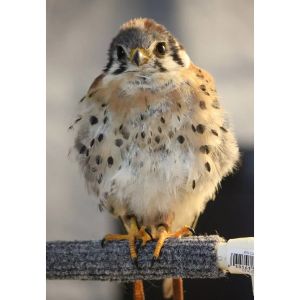
American Kestrel Characteristics:
- Scientific Name: Falco sparverius
- Size: 7-12.2 inches
- Weight: 18-0.76 lbs
- Wingspan: 1-24.0 inches
- Life span: less than 5 years
- Conservation Status: Least Concern
The American kestrel, also known as the sparrow hawk, is the most widespread, colorful, and smallest falcon in CT.
These birds of prey flaunt white faces, dark gray heads with variable crown rufous, white throats, black-blue bills, and distinctive vertical lines on their face.
They have spotted orange bellies and breasts, red-brown backs, and spotted blue-gray wings.
Their tails are reddish-brown with variable bands with yellow feet and legs.
Despite their small size, American kestrels can swiftly snatch prey mid-air.
These falcons inhabit various environments, such as pastures, grasslands, meadows, plains, deserts, and residential areas.
One of their common hunting strategies is hovering in the air at a fairly low height, searching for grasshoppers, crickets, beetles, dragonflies, cicadas, birds, and small rodents.
They also perch on trees and wait for mice, voles, frogs, lizards, and small birds to step into the open.
12. Merlin Falcon
Merlin Falcon Characteristics:
- Scientific Name: Falco columbarius
- Size: 4-11.8 inches
- Weight: 35-0.53 lbs
- Wingspan: 9-26.8 inches
- Life span: 6-8 years
- Conservation Status: Least Concern
Merlins may be relatively small falcons but are fierce fliers and hunters. They are commonly found in CT during migration season.
All Merlin species have dark or slate gray upperparts, dark backs, and pale undersides with short lines ranging from white to brown.
These birds of prey have small curved bills with yellow skin at the base and around the eyes.
Depending on the type, Merlins inhabit coastal areas, open shrubs areas, and forested openings adjacent to water bodies.
They mostly hunt small birds and supplement their diet with insects and reptiles.
These hunters chase their prey at high speeds to exhaust them and then move in for the kill.
They also hunt in pairs, with one falcon chasing prey into the air and the other catching it from above.
13. Turkey Vulture
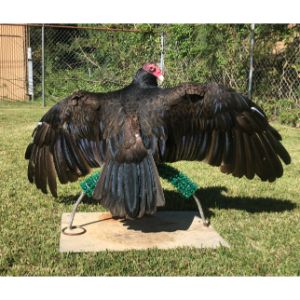
Turkey Vulture Characteristics:
- Scientific Name: Cathartes aura
- Size: 25-32 inches
- Weight: 0-5.0 lbs.
- Wingspan: 63-72 inches
- Life span: 15 years
- Conservation Status: Least Concern
Last on our list of birds of prey in CT is the turkey vulture or turkey buzzard.
This is the most common vulture in the United States and is fairly easy to identify due to all-black plumage, bald red head, and pinkish bill.
As the name suggests, they resemble turkeys; however, they are larger in size, and when in flight, their wide wings become slightly raised and form a distinctive ‘V.’
Their wings have gray coloring underneath and feature fierce, dark brown eyes with light-colored bills.
Turkey vultures inhabit various environments but are most commonly seen in open and semi-open areas adjacent to woodlands.
Moreover, they require open grasslands, deserts, shrublands, and wetlands for foraging and moderate to high hills and mountains for a height advantage before swooping to hunt.
Turkey vultures have a highly developed sense of smell; they can detect carrion (dead or decaying animals) from 8 miles away!
They feed on roadkill or washed-up fish and occasionally kill small or weakened animals.
Frequently Asked Questions
What looks like a hawk but is bigger?
An eagle has a wider wingspan than a hawk.
How do you know if a hawk is around?
If your bird feeders are unusually silent, there might be a hawk or another bird of prey around.
How do I keep hawks away from my house?
Wind chimes are a good way to keep hawks away.
All Birds of Prey in CT
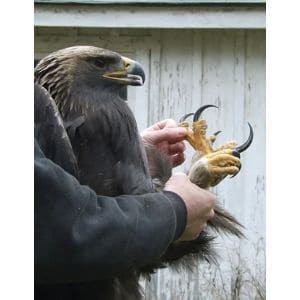
Birds of prey help are a vital part of the ecosystem. They help balance and maintain rodent populations and remove carcasses from the environment.
We hope this guide will help you identify some of these birds next time you go birdwatching in CT.
Although deforestation and increasing human population have resulted in some of these raptors losing their habitats, it is not too late to start preservation programs and protect these magnificent species.
If you find this guide, “All Birds of Prey in CT ,” informative and helpful, you can check out these other bird-related articles from our team:
You can learn more about birds by watching “How to Tame & Take Care of Your Pet Bird | Parakeet Budgie Compilation” down below:

